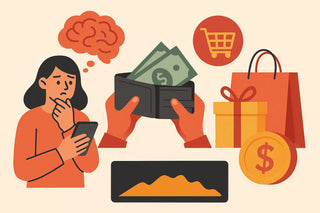Ever looked at your bank account and thought, “Where did all my money go?” You’re not alone—and it’s not just about math or discipline. Your brain, habits, and emotions are all playing a role in how you spend money. This is the psychology of spending, and understanding it is the first step to taking back control of your budget.
Let’s explore how your brain can sabotage your financial goals—and what to do about it.
1. Why We Overspend: It Starts in the Brain
Our brains are wired for survival, not long-term financial planning. The limbic system—responsible for emotions and reward—can easily override the rational part of the brain, the prefrontal cortex.
That’s why:
-
Spending feels good (hello, dopamine rush!)
-
Saving feels boring (no instant reward)
-
Budgeting feels restrictive (loss aversion in action)
We often spend money not because we need something, but because we want to feel better, impress others, or escape stress. This is where behavioral finance and consumer psychology intersect.
2. The Role of Emotional Spending
Emotions often drive financial behavior more than logic. Emotional spending happens when we buy things based on how we feel, not what we need.
Common emotional triggers include:
| Emotion | Common Spending Trigger |
|---|---|
| Stress | Takeout, streaming subscriptions |
| Boredom | Online shopping “just browsing” |
| Sadness | Comfort items: food, clothes, alcohol |
| Happiness | Celebratory spending (gifts, trips) |
Tip: Pause before a purchase. Ask: “Am I solving a problem, or chasing a feeling?”
3. The Problem With “I Deserve It” Thinking
Modern marketing plays into our psychological need for reward. You see it in slogans like:
-
“Because you’re worth it.”
-
“Treat yourself.”
-
“You only live once.”
This kind of mindset makes it easy to justify unnecessary expenses—turning small splurges into big budget busters.
Learning to distinguish between self-care and self-sabotage is crucial. One supports your long-term goals, the other undermines them.
4. The Pain of Paying—and How We Numb It
Research shows that parting with money literally activates the pain centers of the brain. But certain payment methods reduce this pain:
| Payment Type | Pain of Paying | Example |
|---|---|---|
| Cash | High | You physically feel the loss |
| Credit Card | Low | Easy to detach from reality |
| Mobile Payments | Very Low | One click, no awareness |
This is why using cash or debit cards for discretionary spending can help curb impulsive buying.
5. The False Security of “Small” Purchases
You might not buy designer shoes every month, but what about:
-
$7 lattes
-
$15 streaming subscriptions
-
$12 lunch deliveries
These micro-purchases are sneaky. They add up fast and give a false sense of affordability. One of the most effective budgeting strategies is tracking every dollar, even the small ones.
You can try this out as part of a 30-day savings challenge to regain spending awareness.
6. How Advertising Hijacks Your Brain
Marketers are trained in neuroscience. They use tactics that appeal to your emotions and subconscious:
-
Urgency: “Limited time only”
-
Social proof: “Bestseller,” “Everyone’s buying it”
-
Anchoring: Showing high-priced items first to make the next ones look like a deal
Understanding these tricks makes you less vulnerable.
7. Are You a Saver or a Spender by Nature?
Your spending habits are partly shaped by your personality and upbringing. Ask yourself:
-
Did your parents talk about money?
-
Were you rewarded with gifts or money as a child?
-
Do you associate money with freedom, fear, or status?
Knowing whether you're a natural saver or spender helps you design a budget that actually sticks. Learn more in this post about understanding your financial identity.
8. Tricks to Outsmart Your Brain
If your brain is sabotaging your budget, here are tools that actually work:
| Strategy | Why It Works |
|---|---|
| Automate savings | Removes the temptation to spend |
| Set “cooling off” periods | Builds time for rational decisions |
| Use cash envelopes | Tangible limits reduce overspending |
| Track spending daily | Builds awareness and accountability |
| Visual goals (vacation photo) | Taps into emotional motivation |
Need more support? A retirement manager or financial advisor can guide you through habit changes and personalized strategies.
FAQ: The Psychology of Spending
Q1: Why do I feel guilty after shopping?
Because emotional spending brings a temporary high followed by regret—especially if you’re not aligning spending with your values.
Q2: Can spending be addictive?
Yes. The dopamine response is real. Shopping addiction, or compulsive buying disorder, is a recognized behavioral issue.
Q3: How can I stop emotional spending?
Track your triggers, journal before purchases, and create alternative coping habits like walking, calling a friend, or budgeting apps.
Q4: Is budgeting always the solution?
Not alone. Budgeting without addressing the why behind spending is like treating symptoms without curing the cause.
Final Thoughts
Your spending habits aren’t just about numbers—they’re deeply rooted in psychology, emotion, and environment. But you’re not powerless. By learning how your brain works, spotting the patterns, and using science-backed strategies, you can regain control.
Small mindset shifts lead to big money changes. Start today.
